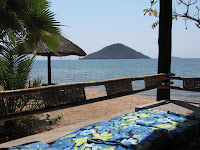
The food sellers surrounded the bus to sell the travellers in the bus their goods; they had boiled eggs with small packets of salt, bread rolls with fried eggs, chilled water in small plastic bags that the locals nibbled the corner of to drink the water, frozen flavoured ice drinks in plastic bags, mangoes, packets of factory made biscuits, fried bread, homemade samosa and chilled canned and bottled soft drinks.
We all managed to find a seat in the crowded bus and I sat next to a large lady with a young boy. The boy drank 2 bottles of fanta, ate 2 packets of biscuits and half a bread bun and grizzled if his mum wanted any of it. The person across the aisle from us had a small puppy tied up in a piece of fabric and it whined the whole time.
The women usually wear everyday clothes and then had a length of brightly coloured material that they use to tie their babies to their backs. If they are wearing jeans or a skirt they will still tie a sarong like piece of material around their waist that covers their clothes. Often they will tie their money into the corner of the sarong.
Three hours later we arrived, after many short stops, at Monkey Bay. We were hustled onto the back of a flat deck truck and twenty five of us headed for Cape Maclear.
The backpackers was called Fat Monkey and seemed to be run by Zimbabweans. It was right on the lake going down to the beach and not as nice as the place at Senga Bay because it was pretty dusty and there was no grass to keep the place cool. The restaurant area looked over the sandy beach out to the water and occasionally the locals would look up and wave or the children would beg for food.

There were 2 Dutch girls and an English guy staying who were doing their internship at a hospital in the north. Later a Dutch couple arrived who were catching up with a friend who taught in Lilongwe and then one evening a whole safari truck full of retired Dutchies arrived to camp at the backpackers. We couldn't believe how many Dutchies there were in such a small place.

When you are walking about the local young men come up to talk to you and inevitably they are trying to sell you a trip on a boat like this one. Patrick and Linda headed off to do some snorkeling and we went exploring the village. When we walked along the beach we saw lots of small snail shells and decided that it was not a good place to go in the water because of the bilharzia. No one in the camp told us it was in the lake here and when we asked they said yes there was bilharzia but we could go to the local clinic and get pills for it. Cape Maclear used to be a popular place for travellers but because the local boys on the beach hassle the travellers they no longer come in the numbers they used to and we only saw one other traveller at another place along the beach.

The locals in their dugouts heading off to fish.
In the village the young boys begged for money and pens. No one seemed to be at school and the kids were in and out of the water all day.
The electricity was off most of one day and on and off the others. We did read that they produce more electricity than they use but must be selling it on to other countries as none of the rural village mud and thatch houses have electricity.
Did some research on where to go and found that the border crossing to Mozambique that we had chosen, meant we would have to go on the carrier of a bicycle taxi for 19 kms so changed our plans and headed for Blantyre to cross at a more popular route.
Said our goodbyes to Patrick and Linda who stayed on with the Dutch couple and were headed for Liwonde and Zomba and then onto South Africa to catch their flights home in early December.
We had to get up at 4 AM to get the minibus back to Monkey Bay and then onto Mangochi. The minibus cruised up and down the village looking for passengers to fill up the seats and just as we got the last one they went back to the village centre and loaded up 3 gas cyclinders about 900 mm high and tied them to the front seats with strips of old tyre tubes and moulded the passengers around them!









































